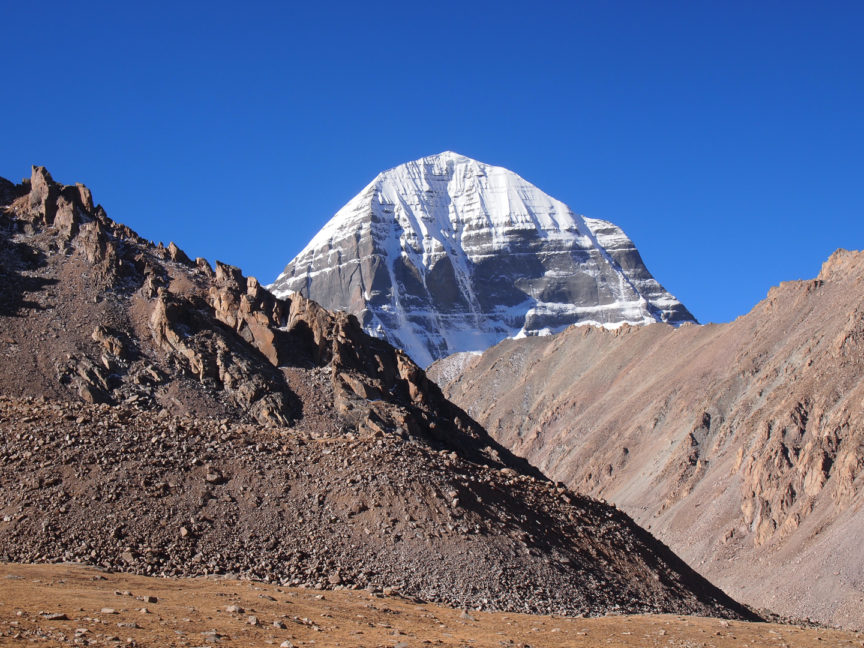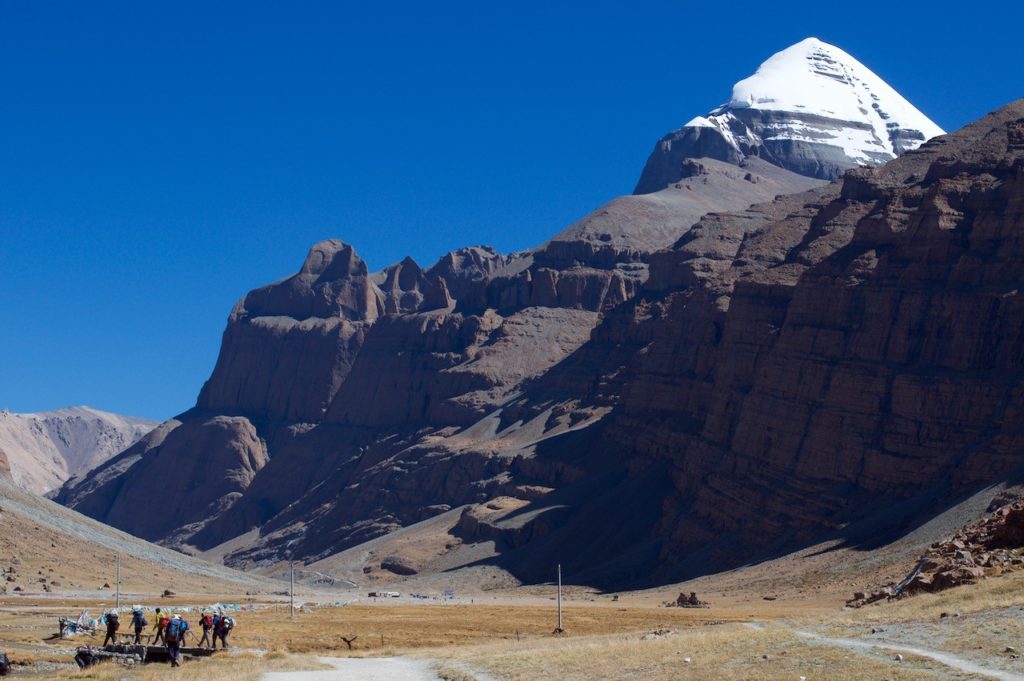Mt. Kailash (Kang Rinpoche/གངས་རིན་པོ་ཆེ) in Western Tibet (TAR) is one of the most venerated religious sites in the world. Four separate religions consider the mountain holy, so it is no surprise that it is pilgrimaged by thousands each year. Conceivably, that number would most likely be greater if it weren’t so difficult to obtain permits to the area. Kailash is viewed by many in the Hindu-Buddhist worldview as the center of the world. Theories regarding its supernatural power abound, with some even claiming it is a pyramid that was built by aliens. Regardless of your personal belief, there are some very interesting facts about the mountain, many of which have only served to add to the various religious beliefs.
Mt. Kailash: The Holiest Mountain
Buddhism
Mt. Kailash is believed to be the abode of Demchok and Dorje Phagmo. Demchok is one of the Buddhist gods, and is also known as Samvara. Dorje Phagmo is the highest female reincarnation, and the third highest person ranking in the hierarchy after the Dalai Lama and the Panchen Lama.
No one has ever climbed Kailash, except the legendary Mila Repa (a sage), who apparently did battle with the forces of darkness on top of the mountain and won a victory for Tibetan Buddhism (see Bon below for the parallel).
Of note for Buddhists is the natural shape on the south face of the mountain. Also called, “the Swastika mountain”, the South face appears to have a natural swastika running from top to bottom and from side to side. This swastika is the result of a vertical cleft running down the center of the rock face, combined with a layer of horizontal strata that appears to complete the symbol. The swastika is used to depict spiritual strength in Buddhism, thus only elevating the significance of this holy mountain.
Hinduism
Hindus have come to believe that Kailash is the mountain spoken of in their epic tales: Mt. Meru – home of the gods. As such, Kailash is believed to be the residing place of Shiva, the god of destruction, and his consort Pirvati. For Hindus, making the difficult pilgrimage to Mt. Kailash and viewing the darshan (divine view) of Shiva’s dwelling place is said to attain release from the clutches of ignorance and delusion.
Jainism
Mount Kailash is known by the Jains of India as Astapada. It is believed that this mountain was the place where the first of their saints (tirthankara) – one by the name of Rishaba – entered Nirvana.
Bon (Ancient Tibetan Religion)
To the Bon-po believers, the mountain is called Tise, and is held as the seat of the sky goddess Sipaimen. It is also said to be here that the Buddhist sage Mila Repa (as previously mentioned), battled the Bon shaman Naro Bon-chung to displace Bon as the primary religion of Tibet. This battle of sorcery between the two religions is said to have taken place during the 12th century.
Kailash’s Natural Significance
However you choose to regard the religious significance of this peak, you cannot argue with its natural beauty, and geographical significance. Mt. Kailash has four faces perpendicular to each other, and each face aligns perfectly with the four cardinal directions. Four great rivers originate from this mountain and flow into the Indian subcontinent (Indus, Sutlej, Brahmaputra, and the Karnali which feeds into the Ganges), and this area is also key to the drainage system of the Tibetan plateau. Tibetan Buddhists call the mountain Kang Rimpoche, the ‘Precious One of Glacial Snow’, as the peak is snowcapped year-round.
Many travelers choose to trek around the base of Mt. Kailash and join the many pilgrims walking the kora around the mountain. The kora typically takes 3 days to complete (although it can be more) with Buddhists going clockwise, and Bon adherents counter-clockwise. Accommodation along the kora can be found in semi-permanent seasonal tents provided by local entrepreneurs making a living from both foreigners and local pilgrims alike. While hiking around the mountain is allowed, summiting the mountain is not. Permission has only been granted on a few occasions in history, none of which were successful in summiting. As could be expected, the sacredness of this mountain to the local Tibetan community means that there is significant resistance to climbers attempting to reach the summit. For the sake of peace, the Chinese Government maintains the mountain is off limits to climbers.


